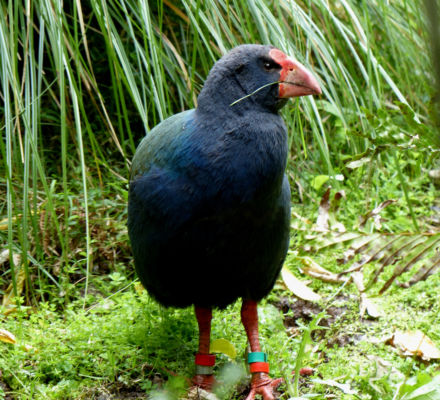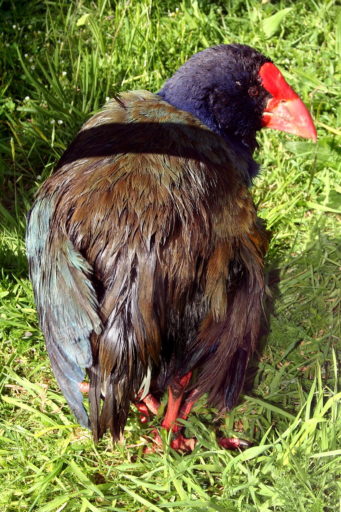April is ‘Takahē Awareness Month’ and really it seems like the big blue/green bird could do with some extra publicity. A check of the ‘Bird of the Year’ winners for the 14 years since it was established in 2005 reveals that the takahē has never once made the top slot. Even its common cousin the pukeko has made it to the winner’s podium on one occasion (2011). So takahē – April is your month. Will 2020 also be your year?

The Bird of the Year online voting doesn’t begin for a few more months yet, so in the meantime, what do we know about the Murchison Mountains’ iconic bird?
The takahē is famous for its dramatic ‘comeback’ from extinction, when it was rediscovered after 50 years of supposedly being lost. Following Dr Geoffrey Orbell’s rediscovery in the Murchison Mountains in 1948, 50,000 hectares was declared a ‘Takahē Special Area’, with public access restricted. But only parts of it are suitable habitat for takahē, mainly the alpine head basins and grassy valley floors.
According to the Department of Conservation, the Murchison Mountains takahē population has had its ups and downs since 1981 when more intensive management of takahē began due to their declining numbers. The population reached its lowest point of 77 in 2015 following back-to-back stoat plagues and a major flooding event and landslides in which birds were killed, but the population has been climbing steeply since then and now exceeds 400 birds.
With an estimated carrying capacity of 190 to 200 birds, the ‘Takahe Special Area’ was deemed to ‘full’, in 2019 with the release of 41 additional captive-reared birds. The Murchison Mountains are no longer the takahē’s only refuge, however. As well as the Burwood Takahē Centre near Te Anau where the released birds were raised, takahē can now be found at a number of ecosanctuaries around New Zealand.
Captive rearing has proved a successful strategy for increasing takahe numbers and, in 1985 when the Burwood Takahē Breeding Centre was purpose built, it became famous for historically using puppets and models to rear takahē chicks. Puppets helped chicks form a proper takahē identity – but you can only learn so much from a puppet.
Young takahē destined for release into the Murchison Mountains must spend some time in their first winter learning to grub for the rhizomes of summer green fern (Hypolepis millefolium). This is so they can find food when winter snows force them out of subalpine tussock down into the forest.
While takahē instinctively know to grub for food, they do not seem to recognise the underground rhizomes of the fern as food unless taught to find them by other takahē.

An 80 hectare predator-free enclosure was built in the adjacent Burwood Bush (Red Tussock) Scientific Reserve to house juvenile birds as well as a few resident breeding pairs. The tussock reserve provides similar conditions to the home of wild takahē in Fiordland. It holds similar food plants, including tussocks and sedges with beech forest containing vital winter food including the summer green fern. These small areas of fern are fenced off and small groups of young birds are put into the pens with a pair of older birds for just a few days to learn the essential survival skills.
With 20-23 pairs of breeding takahē, the Burwood facility has now moved away from intensive hand-rearing. Eggs are left on the nest rather than placed in artificial incubators and chicks are left to be reared by adult takahē as opposed to models and puppets.
In the wild takahē territories can vary from 5 to 60 hectares dependant on the quality of the habitat and the time of year. But at Burwood, takahē are housed in 1.5–2 hectare enclosures and the productivity of the birds is maximised through supplementary feeding, nest manipulation and genetic management. To protect the vegetation in the pens and to ensure sufficient nutritious food is available, takahē are fed special takahē pellets developed by Massey University.
A significant milestone was reached early in 2018, when the Takahē Recovery Programme released 30 takahē in the first wave of translocations into Kahurangi National Park, centred on the Gouland Downs area – creating a second wild population.
According to the Department of Conservation, after achieving a consistent 10% growth over the past four years, coupled with the current takahē sites nearing capacity, the Takahē Recovery Programme was in a position where establishing a new wild population was both feasible and necessary. Gouland Downs in Kahurangi National Park was selected as the most suitable location, for the following reasons:
- There is historic presence of takahē recorded from the wider area.
- The palatable plant species, breeding habitat, topography, climate (milder than Murchison Mountains), availability of water, and low numbers of predators are all favourable to takahē persisting at this site.
- There is an extensive predator control regime in place, as part of the Air New Zealand funded Biodiversity Enhancement Project that has been operating for many years. Gouland Downs offers the best balance of suitable habitat with low predator numbers. Note: There are sites that contain better takahē habitat, but there are cats and ferrets present and inadequate predator control in place.
- The Takahē Recovery Programme estimates a carrying capacity of Gouland Downs to be 40 pairs, with the possibility of a further 20 pairs at nearby Mackay Downs. This will create a large enough population to not require intensive management and therefore be “wild”.
- The site is on existing DOC tenure and offers good site access and infrastructure which will make post-release management much easier.
The site is on the Heaphy Track, one of the Great Walks so in years to come, the public may be able to observe takahē in the wild when out on a family tramp. Could Dr Geoffrey Orbell ever have imagined that?
How far the takahē has come. Not bad for an ‘extinct’ bird. Happy April, takahē – this is your month!
Read more about the Takahe Recovery Programme.

